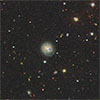| Jan 18, 2022 |
|
|
|
(Nanowerk News) Appearing ten to a hundred times brighter at its peak, and with a much faster rise toward the peak, stellar explosions AT 2018cow (nicknamed the COW) and SN 2018gep (nicknamed the GEP) represent a new type of supernova called Fast Blue Optical Transient (FBOT), reports two recent studies.
|
|
Thanks to recent extensive supernova observations by several telescopes worldwide, COW and GEP appeared in the night sky in 2018 and were well-observed from the early phase of their explosions (figure 1). But their origin was a mystery.
|
 |
| Figure 1: Supernova AT 2018cow, nicknamed the COW. (Left) Following its explosion, COW reached peak luminosity on June 20, 2018, being much brighter than the galaxy’s center at upper left. (Right) By July 14, 2018, COW had become dimmer, becoming just as bright as the galaxy’s center. (Image: Daniel Perley (Liverpool J. M. University), Kavli IPMU)
|
|
To find a theoretical model, Shing-Chi Leung, a former Kavli Institute for the Physics and Mathematics of the Universe (Kavli IPMU) Project Researcher (currently a postdoctoral scholar at the California Institute of Technology), and Kavli IPMU Senior Scientist Ken’ichi Nomoto, organized two international teams of researchers to study each explosion, and have now succeeded in explaining COW and GEP features (The Astrophysical Journal, “A Model for the Fast Blue Optical Transient AT2018cow: Circumstellar Interaction of a Pulsational Pair-instability Supernova”).
|
|
Observational data showed the COW had the brightest peak and the shortest rising time (about 1 day) among FBOTs. The GEP had a slightly lower brightness and a longer rising time (about 3 days), compared to the COW (figure 2).
|
 |
| Figure 2: Light curve of supernova SN 2018gep (GEP) shows it reaches a higher peak luminosity rapidly compared to ordinary Ic supernovae (solid lines). (Image: Anna Ho (Caltech), Kavli IPMU)
|
|
Both research groups then successfully modeled the light curve, uncovering a clear picture of a possible sequence of events in both explosions (figure 3).
|
|
First, the star would have ejected its surface materials just before the explosion. These ejected materials would have formed a dense and opaque circumstellar matter (CSM) around the star, making the radius of the star much larger than ordinary presupernova stars. Such a presupernova mass ejection mechanism might have been caused by the pulsational pair-instability of very massive stars, which Leung and Nomoto had previously seen while studying the origin of massive black holes.
|
 |
| Figure 3: Cartoon illustration of the shock-interaction picture. (Upper left) A massive star undergoes large pulsations due to electron-positron pair-creation and ejects some material to form dense circumstellar matter. (Upper right) The star explodes to form a shock wave, which propagates through the circumstellar matter. (Lower left) When the shock wave reaches the surface of the circumstellar matter, the kinetic energy is converted to the thermal and radiation energy. Then the surface of the circumstellar matter shines very brightly. Material ejected by supernova explosion expands at moderate speeds. (Lower right) Circumstellar matter rapidly expands and fades. Supernova ejecta also expands and fades. (Image: Shing-Chi Leung, Kavli IPMU)
|
|
When the supernova explosion occurred in the star, a strong shock wave would have formed and propagated through the CSM. When it reached the CSM surface, its kinetic energy would have converted into thermal and radiation energy, causing a sudden and a very bright event to occur, which is consistent with the very fast rise of the observed brightness of the supernova.
|
|
The CSM surface became as bright as observed peak of COW because of the large “radius”, but once CSM quickly lost most of its energy and faded, it became transparent, giving way to an ordinary supernova light.
|
|
The theoretical supernova light curves powered by the shock-heating of the CSM the researchers created were found to be in good agreement with the observational data of the COW and the GEP, respectively (figure 4).
|
 |
| Figure 4: Theoretical shock-interaction models for the light curves and comparisons with observational data from the COW and the GEP. Solid lines are the models including the self-consistent CSM. Dashed line are the models assuming the CSM is artificially removed. (Image: Shing-Chi Leung, Kavli IPMU)
|
|
The researchers also found that without CSM, the rising of the light curve was much slower and the maximum luminosity was much lower, indicating FBOTs can be linked to CSM-heating.
|
|
The research teams are now proposing that the variation the CSM mass formed from the pulsational pair-instability of very massive stars would cause variation among FBOTs. If the CSM mass is large enough, the resulting supernova would be observed as a so-called Superluminous Supernova which is bright but shows much slower rising.
|
|
The next step is to confirm this hypothesis with more observations.
|








